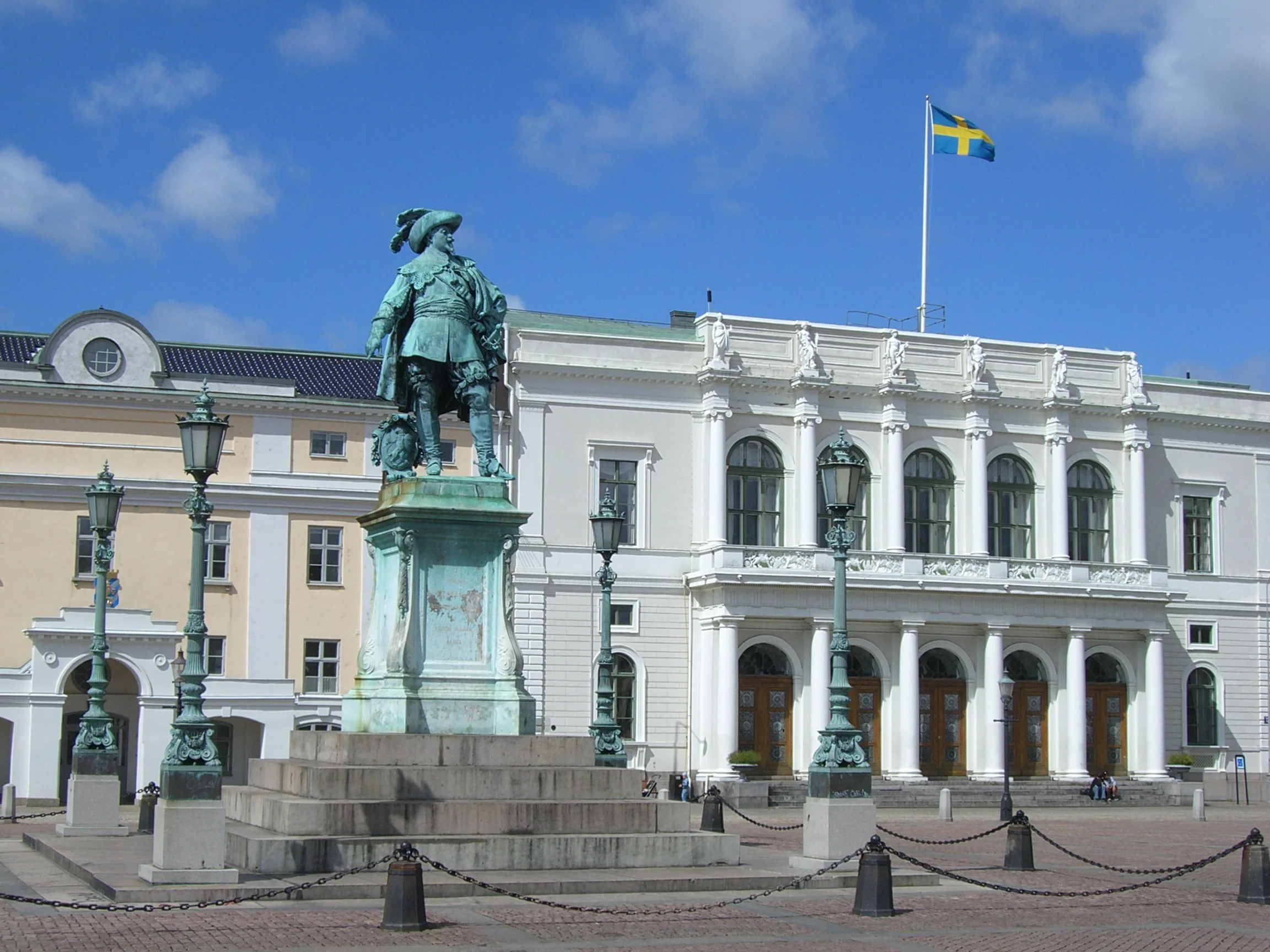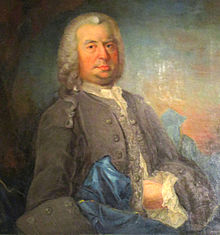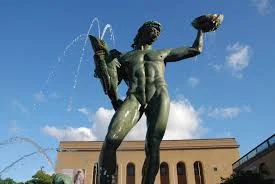The ultimate Gothenburg history walk
Begin at Skansen Kronan (see map at the bottom) and take in the superb view over the city. Look out for the golden glimmer of Skanka Lejonet, Gothenburg’s second fort, in the distance. Then drop down into the cosy cobbled streets of Haga, walk along the tree-lined path of Vienna-inspired Vasagatan and cover the remaining points as you please.
Pre-Gothenburg
Settlements in the Gothenburg area date back to the Middle Ages. The town of Lödöse was located 40 km upstream from Gothenburg on the Göta River. However, this trade centre and port town struggled with interference from pesky Norwegians and Danes at the Bohus Fortress (present-day Kungälv) from where they controlled the ships heading to and from Lödöse.
In 1473, the town moved to a new location where the present-day suburb of Gamlestan sits. Then, nearly fifty years later, a King said...
“This looks like a good place”
King Gustavus Adolphus is the guy to thank for choosing Gothenburg’s location. In 1619, he pointed to a patch of watery marshland with his royal finger and said, “Here, the city shall lie” – a moment immortalised by the statue erected in 1854 at Gustav Adolf’s square. He stands in front of The Gothenburg City Hall, Wenngrenska Huset and Börsen (Commodity Exchange). The City Hall has stood in its place since 1673 with Wenngrenska Huset, originally a private residence, built in 1749. The construction of Börsen was funded by the city’s merchants and opened in 1849.
King Gus founded the city (but probably did none of the work).
Bring the Dutch in
When you’re building a city on marshland, who you gonna call? Dutch builders! Course you are. And the influence of the Dutch is still visible in modern-day Gothenburg. The city’s famous canals are Dutch-inspired as is the chequered street system which resembles those of Jakarta and Manhattan (New Amsterdam) also built in the same era.
Built for protection
Gothenburg was founded as a heavily fortified town in 1621. This was in the midst of the Thirty Years’ War (1618-1648) and the declining influence of the Catholic Church. Battles were fought across Europe, centred mainly on modern-day Germany. At the time, Gothenburg represented Sweden’s only direct access to the North Sea and the Atlantic Ocean beyond: it was a highly strategic location.
"If your name's not on the guest list..."
The original city was built inside a large zigzag-shaped wall which would characterise Gothenburg for hundreds of years. Today, very little of this wall remains, though a section of the bastion Carolus Rex XI can be seen at Esperantoplatsen.
The construction of the two forts, Skansen Lejonet and Skansen Kronan was completed in 1694 and 1698 respectively. Originally outside the city walls, Skansen Kronan is found in the beautiful district of Haga and offers a great city viewing point. Which, to be honest, is all it’s been good for! In all its years, not a shot has been fired.
Skansan Kronan has looked over Gothenburg and protected the city from nobody, for more than 300 years.
Built in 1654, Kronhuset is Gothenburg’s oldest existing building. Originally used to store military equipment, it has no internal supports to enable easy manoeuvring of canons. Now that the canons have gone, Kronhus and the surrounding cottages are thriving craft centres and shops including glassworks, watchmaking, furniture, pottery and leather. There is a great pub on the corner of Kronhusgatan, Olrepubliken (The Beer Republic), if you’re feeling thirsty!
Around this time, Gothenburg officially became part of Sweden, for a short time Swedes just had a right to occupy the area. However, after a series of devastating defeats, Denmark-Norway ending up giving a third of their territory to Sweden. The Treaty of Roskilde signed in 1658 also granted Gothenburg and nearby Marstrand the only rights to deal with foreign merchants. That was great for business.
Boom and burn
The growth of Gothenburg during the 18th Century is epitomised by the Swedish East India Company. Founded in 1731 by Scotsman, Colin Campbell and Swede, Niclas Sahlgren, for the purpose of trading with the Far East; it grew to become the largest trading company in Sweden until folding in 1813. East India House, erected in 1762 stands as a testament to this hugely significant Gothenburg company. It's been the Gothenburg city museum since1895 and lies down the road from the beautiful Christanae Church, a German church inaugurated in 1748 for German and Dutch settlers.
Niclas Sahlgren #loaded
Unfortunately, none of Gothenburg’s original wooden buildings remain for us to enjoy today, due to a series of 18th Century fires. However, the city’s first church, built in 1633, has displayed a knack of recovering from the flames. After elevation to cathedral status in 1665, “Gustavi Church” as it was originally known, was first damaged by a fire in 1721. Fortunately, the walls of the cathedral remained largely intact and it was re-opened just 13 months later. In 1802, a more severe fire struck the cathedral. It took over 20 years to rebuild this time: the result is the building known today as, Domkyrkan, inaugurated in 1825.
19th Century markets you can still visit
The iconic Feskekörkan (The Fish Church) opened in 1874. Of all the world’s many fish markets, few can claim to have a home quite as elegant as this. Apart from buying fresh fish, you can also eat at the market’s own seafood restaurant.
Feskekörkan in Gothenburg, the holiest fish market in the world.
A short walk along the old moat is Gothenburg’s largest market place which, since the mid-19th Century, has been located on Kungstorget. In 1850, a semi-circle of market stalls was built around the side of Kungstorget closest to the water. Later, in 1889, Stora Saluhallen was opened. It’s still the city’s largest indoor market with around forty delicatessens and places to eat, selling food from all over the world. Very popular for weekday lunch!
Across from Stora Saluhallen lies Kungsportsplatsen. This square was constructed in 1852 and takes its name from the King's Gate (the name literally means The King's Gate Place). This gate was once the main entrance into the fortified city and, although now removed, you then can see the importance of the entrance in the existing bridge’s stature. The man on a horse at Kungsportsplatsen is King Charles IX, he ruled Sweden between 1604-1611 and was the father of Gustav Adolf who founded Gothenburg. Charles himself had himself founded a town on Hisingen island, across the river from Gothenburg; Danish aggression meant it was short-lived! His statue was erected in 1936.
The Last Century – this is Gothenburg
In the 20th Century, two monuments that have come to symbolise Gothenburg made their home here.
Poseidon has great bait for catching fish.
At the top of the Avenyn – a mid-19th Century, Paris-inspired boulevard – lies the statue of Poseidon. Proudly standing in Götaplatsen, a square constructed when Gothenburg hosted the World Trade Fair in 1923, the statues were added in 1931. It must be said that the Greek God clearly struggles with the colder weather here but enjoys his cultural neighbours: the Gothenburg Concert Hall, Museum of Art and City Theatre.
The Barken Viking ship will never leave Gothenburg.
The second of Gothenburg’s famous residents is The Viking sail ship. Also known as the Barken Viking, built in 1906, she was reportedly Scandinavia’s largest ever. Originally used as a training ship for the Danish merchant fleet, she later competed in races, winning the Great Grain Race from Victoria, Australia to Falmouth, England in 1948. Two years later, the Viking came to Gothenburg. She has since been joined at Lilla Bommens port by the iconic Läppstiftet or “Lipstick” building (1989) and Gothenburg’s Opera House (1994). The Älsvsborg suspension bridge, erected in 1966, has effectively locked the poor Viking in; her masts being taller than the bridge. She will never leave Gothenburg to sail the open seas again, but – let’s be honest – why would she want to?!
This Is Gothenburg [2023]
THE LATESTS PICS & NEWS ON INSTAGRAM
















